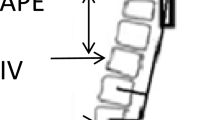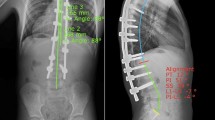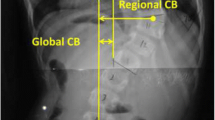Abstract
Purpose
Proximal junctional kyphosis (PJK) has been reported to occur at a rate of about 30% in traditional growing rods (GR) and magnetically controlled growing rods (MCGR). Growth guidance systems (GGS) have non-rigid, gliding fixation along rods, which may mitigate PJK. There have been no studies done in shilla around PJK, hence this study aimed to assess the occurrence, risk factors, and timeline of PJK.
Methods
A prospective, multicenter database was queried for EOS patients who underwent surgery utilizing GGS. Inclusion criteria: < 10 years at index surgery and > 2 year follow-up.
Results
Sixty-five patients (thirty-six female) met inclusion criteria. Mean age at index surgery was 6.2 y/o (2–9); mean follow-up was 66 m. Most common etiologies were syndromic (n = 23). Mean thoracic kyphosis at pre-op was 41.8°, post-op was 35.5°, and final was 42.2°. Mean PJA at pre-op was 6.15°, post-op 1 was 4.2°, and final was 15.6°. Incidence of PJK at post-op was 35% and final was 43%. Pre-op sagittal balance and change in sagittal balance from pre-op to post-op were associated with post-op PJK (p = 0.05, 0.02). Change in spinal height from pre-op to post-op was associated with PJK at final (p = 0.04). Interestingly, increased PJA at pre-op was significantly associated with decreased PJK at post-op and final (p = 0.01, 0.03).
Conclusion
PJK was identified in 43% of patients post-operatively after GGS for EOS. Pre-op PJA was negatively correlated with an increased incidence of PJK. Changes in sagittal balance, in either direction, was the strongest predictor for development of PJK post-operatively.

Similar content being viewed by others
Data availability
The datasets generated during and/or analysed during the current study are available from the corresponding author on reasonable request.
References
Sardar ZM, Kim Y, Lafage V et al (2021) State of the art: proximal junctional kyphosis-diagnosis, management and prevention. Spine Deform 9:635–644
Cho SK, Kim YJ, Lenke LG (2015) Proximal junctional kyphosis following spinal deformity surgery in the pediatric patient. J Am Acad Orthop Surg 23:408–414
Erkilinc M, Baldwin KD, Pasha S et al (2022) Proximal junctional kyphosis in pediatric spinal deformity surgery: a systematic review and critical analysis. Spine Deform 10:257–266
Inaparthy P, Queruz JC, Bhagawati D et al (2016) Incidence of proximal junctional kyphosis with magnetic expansion control rods in early onset scoliosis. Eur Spine J 25:3308–3315
Watanabe K, Uno K, Suzuki T et al (2016) Risk factors for proximal junctional kyphosis associated with dual-rod growing-rod surgery for early-onset scoliosis. Clin Spine Surg 29:E428–E433
Helgeson MD, Shah SA, Newton PO et al (2010) Evaluation of proximal junctional kyphosis in adolescent idiopathic scoliosis following pedicle screw, hook, or hybrid instrumentation. Spine (Phila Pa 1976) 35:177–181
Mika AP, Mesfin A, Rubery PT et al (2019) Proximal junctional kyphosis: a pediatric and adult spinal deformity surgery dilemma. JBJS Rev. https://doi.org/10.2106/JBJS.RVW.18.00059. (Epub ahead of print April 1, 2019)
Skaggs DL, Akbarnia BA, Flynn JM et al (2014) A classification of growth friendly spine implants. J Pediatr Orthop 34:260–274
McCarthy RE, Luhmann S, Lenke L et al (2014) The shilla growth guidance technique for early-onset spinal deformities at 2-year follow-up: a preliminary report. J Pediatr Orthop 34:1–7
Kim H, Kim HS, Moon ES et al (2010) Scoliosis imaging: what radiologists should know. Radiographics 30:1823–1842
Roussouly P, Nnadi C (2010) Sagittal plane deformity: an overview of interpretation and management. Eur Spine J 19:1824–1836
Glattes RC, Bridwell KH, Lenke LG et al (2005) Proximal junctional kyphosis in adult spinal deformity following long instrumented posterior spinal fusion: Incidence, outcomes, and risk factor analysis. Spine (Phila Pa 1976) 30:1643–1649
Lampe LP, Bövingloh AS, Gosheger G et al (2019) Magnetically controlled growing rods in treatment of early-onset scoliosis: a single center study with a minimum of 2-year-follow up and preliminary results after converting surgery. Spine (Phila Pa 1976). https://doi.org/10.1097/BRS.0000000000003048. (Epub ahead of print 2019)
Pan A, Hai Y, Yang J et al (2018) Upper instrumented vertebrae distal to T2 leads to a higher incidence of proximal junctional kyphosis during growing-rod treatment for early onset scoliosis. Clin Spine Surg A Spine Publ 31:E337–E341
Gomez JA, Kubat O, Tovar Castro MA et al (2020) The effect of spinopelvic parameters on the development of proximal junctional kyphosis in early onset: mean 4.5-year follow-up. J Pediatr Orthop 40:261–266
Piantoni L, Remondino RG, Tello CA et al (2020) Proximal junction kyphosis after posterior spinal fusion for early-onset scoliosis. Spine Deform 8:311–316
Joukhadar N, Kubat O, Heflin J et al (2019) Superior extension of upper instrumented vertebrae in distraction-based surgery: a surrogate for clinically significant proximal junctional kyphosis. Spine Deform 7:371–375
Chen X, Xu L, Qiu Y et al (2018) Incidence, risk factors, and evolution of proximal junctional kyphosis after posterior hemivertebra resection and short fusion in young children with congenital scoliosis. Spine (Phila Pa 1976) 43:1193–1200
Chen Z, Li S, Qiu Y et al (2017) Evolution of the postoperative sagittal spinal profile in early-onset scoliosis: is there a difference between rib-based and spine-based growth-friendly instrumentation? J Neurosurg Pediatr 20:561–566
Chen Z, Qiu Y, Zhu Z et al (2017) How does hyperkyphotic early-onset scoliosis respond to growing rod treatment? J Pediatr Orthop 37:e593–e598
Carender CN, Morris WZ, Poe-Kochert C et al (2016) Low pelvic incidence is associated with proximal junctional kyphosis in patients treated with growing rods. Spine (Phila Pa 1976) 41:792–797
El-Hawary R, Sturm P, Cahill P et al (2017) What is the risk of developing proximal junctional kyphosis during growth friendly treatments for early-onset scoliosis? J Pediatr Orthop 37:86–91
Shah SA, Karatas AF, Dhawale AA et al (2014) The effect of serial growing rod lengthening on the sagittal profile and pelvic parameters in early-onset scoliosis. Spine (Phila Pa 1976) 39:E1311–E1317
Wang Y, Kawakami N, Tsuji T et al (2017) Proximal junctional kyphosis following posterior hemivertebra resection and short fusion in children younger than 10 years. Clin spine Surg 30:E370–E376
Klyce W, Mitchell SL, Pawelek J et al (2020) Characterizing use of growth-friendly implants for early-onset scoliosis: a 10-year update. J Pediatr Orthop 40:e740–e746
Akbarnia BA (2007) Management themes in early onset scoliosis. J Bone Jt Surg 89:42–54
Gomez JA, Lee JK, Kim PD et al (2011) “Growth friendly” spine surgery: management options for the young child with scoliosis. J Am Acad Orthop Surg 19:722–727
Lee GA, Betz RR, Clements DH et al (1999) Proximal kyphosis after posterior spinal fusion in patients with idiopathic scoliosis. Spine (Phila Pa 1976) 24:795–799
Rhee JM, Bridwell KH, Won DS et al (2002) Sagittal plane analysis of adolescent idiopathic scoliosis: the effect of anterior versus posterior instrumentation. Spine (Phila Pa 1976) 27:2350–2356
Koller H, Juliane Z, Umstaetter M et al (2014) Surgical treatment of Scheuermann’s kyphosis using a combined antero-posterior strategy and pedicle screw constructs: efficacy, radiographic and clinical outcomes in 111 cases. Eur Spine J 23:180–191
Lonner BS, Ren Y, Newton PO et al (2017) Risk factors of proximal junctional kyphosis in adolescent idiopathic scoliosis-the pelvis and other considerations. Spine Deform 5:181–188
Kim YJ, Lenke LG, Bridwell KH et al (2007) Proximal junctional kyphosis in adolescent idiopathic scoliosis after 3 different types of posterior segmental spinal instrumentation and fusions: incidence and risk factor analysis of 410 cases. Spine (Phila Pa 1976) 32:2731–2738
Ishihara M, Taniguchi S, Adachi T et al (2021) Rod contour and overcorrection are risk factors of proximal junctional kyphosis after adult spinal deformity correction surgery. Eur Spine J 30:1208–1214
Yan P, Bao H, Qiu Y et al (2017) Mismatch between proximal rod contouring and proximal junctional angle. Spine (Phila Pa 1976) 42:E280–E287
Lafage R, Line BG, Gupta S et al (2017) Orientation of the upper-most instrumented segment influences proximal junctional disease following adult spinal deformity surgery. Spine (Phila Pa 1976) 42:1570–1577
Sacramento-Domínguez C, Vayas-Díez R, Coll-Mesa L et al (2009) Reproducibility measuring the angle of proximal junctional kyphosis using the first or the second vertebra above the upper instrumented vertebrae in patients surgically treated for scoliosis. Spine (Phila Pa 1976) 34:2787–2791
McCarthy RE, McCullough FL (2015) Shilla growth guidance for early-onset scoliosis: results after a minimum of five years of follow-up. J Bone Joint Surg Am 97(19):1578–1584
Luhmann SJ, Smith JC, McClung A et al (2017) Radiographic outcomes of shilla growth guidance system and traditional growing rods through definitive treatment. Spine Deform 5(4):277–282
Funding
No funding was received for this work.
Author information
Authors and Affiliations
Consortia
Contributions
RMA, IM, RM, DS, PS, SL, Pediatric Spine Study Group: substantial contributions to the conception or design of the work; or the acquisition, analysis, or interpretation of data for the work. RMA, IM, RM, DS, PS, SL, Pediatric Spine Study Group: drafting the work or revising it critically for important intellectual content. RMA, IM, RM, DS, PS, SL, Pediatric Spine Study Group: final approval of the version to be published. RMA, IM, RM, DS, PS, SL, Pediatric Spine Study Group: agreement to be accountable for all aspects of the work in ensuring that questions related to the accuracy or integrity of any part of the work are appropriately investigated and resolved.
Corresponding author
Ethics declarations
Conflict of interest
No conflicts exist for any of the authors pertaining to the submitted work.
Ethical approval
No human subjects or animals participated; therefore, no informed consent was obtained. IRB approval was obtained from Washington University Institutional Review Board, IRB 201102008.
Additional information
Publisher's Note
Springer Nature remains neutral with regard to jurisdictional claims in published maps and institutional affiliations.
Rights and permissions
Springer Nature or its licensor (e.g. a society or other partner) holds exclusive rights to this article under a publishing agreement with the author(s) or other rightsholder(s); author self-archiving of the accepted manuscript version of this article is solely governed by the terms of such publishing agreement and applicable law.
About this article
Cite this article
Arhewoh, R.E., Marigi, I., McCarthy, R. et al. Changes in sagittal balance and pre-existing junctional angle influence development of proximal junctional kyphosis in growth guidance systems for early-onset scoliosis. Spine Deform 12, 239–246 (2024). https://doi.org/10.1007/s43390-023-00754-2
Received:
Accepted:
Published:
Issue Date:
DOI: https://doi.org/10.1007/s43390-023-00754-2




